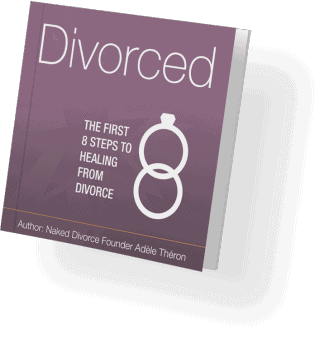
Free e-book: The First 8 Steps to healing from divorce
Extreme Sadness During Divorce: Red Flags You Shouldn’t Ignore

[Warning Signs of Extreme Sadness During Divorce]
What nearly crashing my car taught me about emotional rock bottom.
My story:
I lived very recklessly for a few days after my divorce. I was driving my car, feeling very numb to everyone and everything around me. I wanted to feel alive again so I hit the accelerator. The car went faster and faster. I didn’t care.
Suddenly the road curved to the left. I was seconds from colliding with a wall and even though I saw it, for a moment I wondered how it would feel to crash. I pulled over and sobbed, knowing that I had hit a metaphorical wall. I vowed at that moment to take better care of myself and stop being reckless with my life. I also chose to forgive myself for the rash behaviour, understanding that the numbness I was feeling was part of the healing cycle.
If you’re reading this and you’ve recently gone through a painful divorce or break-up, you may know this feeling too well. And if you’re not sure where sadness ends and something more dangerous begins — this blog is for you.
What is Extreme Sadness During Divorce?
It’s more than just crying at night.
It’s more than grief.
It’s a deep, consuming emotional fog that clouds your judgment, drains your will to care, and slowly disconnects you from life.
Extreme sadness during divorce can show up in subtle ways: you may stop eating, overeat, sleep too much, feel constantly anxious, or become unusually withdrawn. Sometimes it escalates to reckless behavior — like speeding in a car with no real concern for the outcome.
And that’s why we need to talk about it.
Is it Normal to Feel This Way?
Yes — and no.
It is completely normal to feel like your world has collapsed after a break-up or divorce. Feeling hopeless, helpless, numb, or wanting to isolate are all valid and expected parts of the healing cycle.
But there’s a line — and when your sadness crosses it, that’s when it becomes dangerous.
Here’s where the red flags begin.
Extreme Sadness Red Flags (Don’t Ignore These Signs)
If you notice any of the following persisting longer than 7 weeks, it’s time to pause and get support:
-
Ongoing feelings of hopelessness or helplessness
-
Dramatic mood swings
-
Extreme changes in personality
-
Losing interest in activities you once enjoyed
-
Major shifts in sleep or eating patterns
-
Struggling to function at work or in daily tasks
These may seem “normal” during a hard season — and to an extent, they are. But when they linger or intensify, they signal something deeper.
And if you’re experiencing any of the following, please don’t wait:
-
Constant depression or sadness
-
Talking, writing, or even planning your own death
-
Complete isolation from family or friends
-
Feeling trapped with no way out
-
Excessive alcohol or drug use
-
Guilt or shame that feels unbearable
-
Reckless behavior that puts you in harm’s way
-
Giving away prized possessions without explanation
These are not just sad days.
They are loud cries for help — even if you haven’t voiced them yet.=
Why You Need to Take These Signs Seriously
Extreme sadness doesn’t always scream. Sometimes it whispers.
And because divorce grief is so misunderstood, many people dismiss what they’re feeling as “just part of the process.”
But you don’t have to suffer quietly or wait until things get worse. The moment you notice these red flags is the moment to act. Not because you’re broken, But because you’re human. And being human in heartbreak is hard.
Healing Doesn’t Mean “Getting Over It”. It Means Facing It
At Naked Divorce, we’ve supported thousands of people walking this very path. We know that healing isn’t just about time passing. It’s about structure, emotional safety, and taking your power back in intentional ways — day by day.
Our 21-day program was built specifically for this. Not to rush your healing, but to hold it.
And if you’re unsure where to begin or whether what you’re feeling is “normal”. a simple conversation might bring the clarity you need.
You’re Not Broken. You’re Healing.
If you see yourself in any part of this story, please know this:
You are not alone.
Extreme sadness can feel like a black hole — but even the deepest grief carries messages. Messages of what matters, what hurts, and what you’re still capable of becoming.
So pause. Breathe. Reach out.
And when the road curves… choose to turn the wheel.
If you enjoyed this post, I’d be very grateful if you’d help it spread by emailing it to a friend, or sharing it on Twitter or Facebook.
With you in service,


For a more personalized approach to your healing journey, book a free Clarity Call now. Our coaches are here to help you take your first steps towards healing. Check out our Resources or our Videos on YouTube.

